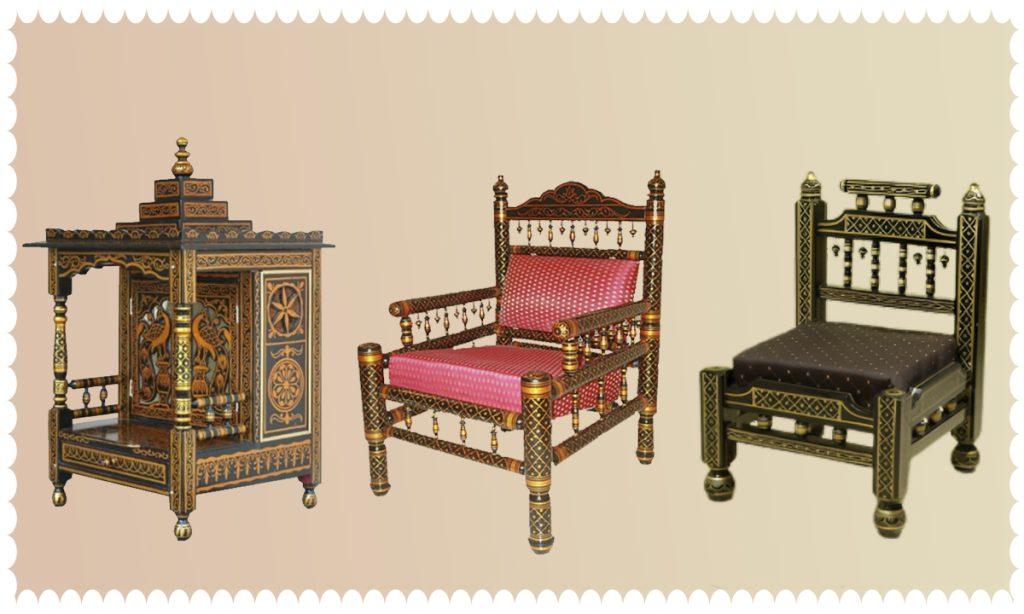The sturdy pieces of furniture which are equivalent to vibrant and exquisite pieces of art designed at the Sankheda town by artisans belonging to the Kharadi community. Sankheda is derived from the Gujarati word ‘Sanghedu’, which refers to lathe or the machine used to turn wood. These are internationally renewed for their grand, hand-painted motifs on shiny lacquered turned teakwood.
A local legend talks about the Suthars who migrated from an old citadel called Champaner due to their land being taken over during a conquest. The people of this community started lac turnery and carpentry in Sankheda around 500 years ago. Two of the Kharadi elders of the community who learned about the transparent lacquer work saw a Muslim artisan on a visit for raw materials in Vadodara. The artisan was painting an egg with tin paints and coated it with lac to give it a shine. His art was his source of livelihood and he got paid by selling his products to royal members. The artisan agreed to teach the Kharadi men, who learned the art in secret. Sankheda furniture is thought to have been an essential part of Vadodara since around the 1820s.
The Ghodiyu or cradle is said to be one of the first things made from the Sankheda furniture. The earliest record of Sankheda furniture is found in the personal accounts of a British civil servant named James Forbes and a French writer named George Rocques. They wrote of the teak furniture decorated in indigenous colours. Physical evidence of it can also be found in the White House, Buckingham Palace, and even the Kremlin. Lacquered turned wood furniture, adorned with hand-painted motifs came to be known as Sankheda furniture. Around 80-100 families from the Kharadi-Suthar community have been engaged in this craft since 1855. Due to their collective involvement and identity, the craft has maintained its continuity, with the skills being passed down to generations. Sankheda furniture has a royal history that dates back centuries. It was an integral part of the Emperors’ and Royal families’ lavish lifestyles. In around 1973, electrically operated lathes were introduced. These replaced the manually operated ones and also increased the production.

Sankheda furniture is painted with traditionally very vivid colours such as rich shades of maroon and gold. More recently, with colour inventions, one now sees shades of black, burgundy, green, blue, copper, ivory, silver, etc. These also make it standout. Written documentation, collection, and art museums found grand Sankheda pieces like the gold lacquer chessboard or ivory plagued sandalwood box. The materials used were expensive and the designs, such as one of Durga fighting demons, suggests that many pieces were specially commissioned by royal members. The designs done on Sankheda furniture can be divided into two categories, i.e., Plain and Ornamental Lacquering.
The plain lacquering consists of rings and bands of various colours. It is considered one of the most ancient designs done on this furniture. In the ornamental lacquering, here detailed motifs like creepers, folk designs, flowers, geometric designs, figure work are done. Some of the popular motifs used are Chokdi (crisscross pattern), circles, peacock, minda, jali, double jali, tapka, birds, animals and leaves. Here, the Chokdi or the checkered lines with dots inside them is widely used and is signature to Sankheda furniture. Traditionally the floral, geometrical patterns were drawn using thick and thin lines. The artisans also experiment with contemporary designs when demanded by the customers. The colours and motifs used here, also hold an auspicious significance.
Sankheda has become increasingly popular in international markets, most notably in the United States of America, the United Kingdom, Russia, and Australia. The craft today has become modernized with motorized machines to turn the lathe and the use of synthetic colours and melamine coating. Over time, craftsmen began to use synthetic colours in their designs. These colours were not naturally grown in their region, so they used it to elevate the product.
Sankheda is considered especially sacred to the Gujarati communities due to the usage of natural ingredients. However, natural lacquer is being replaced by materials such as melamine, which do not give the same shine as the traditional pieces. Despite the changes in colours, mode of production, and materials, the design and symbols have remained unchanged. Also, the promotion of Gujarat tourism has benefited the craft, since its awareness has increased among the tourists and its demand has flourished. Its price increases depending on the intricacy of the design. This also results in high prices of the products.
The artisans also started producing products that were lower in price, so that everyone could afford it. Some of these included wall pieces, rolling pins, toys. These also need less time, raw material and are very popular among the locals and even the tourist who also buy them as souvenirs. The agencies like Garvi Gujarat (Gujarat state handicraft and handloom development corporation limited) were invaluable in early years and played a significant role in the sale of the Sankheda furniture. Even though the artisans are illiterate, they make sure their kids get formal education. This helps them in dealing with the clients and in promoting the craft as well.
